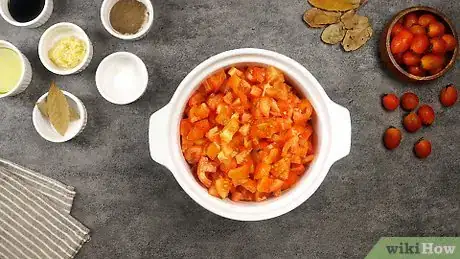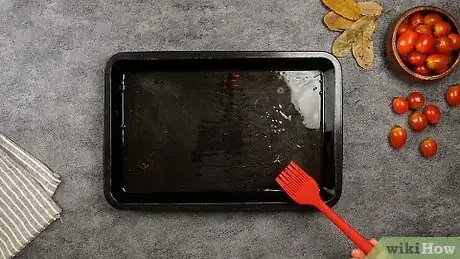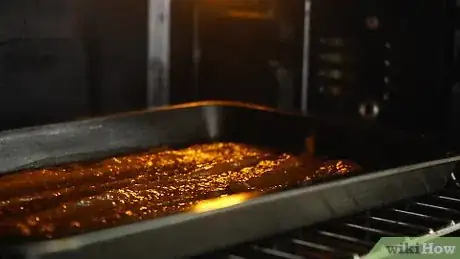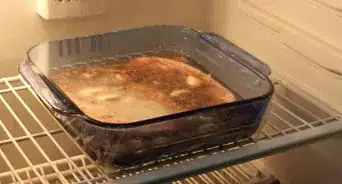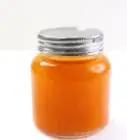This article was co-authored by Tara Coleman. Tara Coleman is a Clinical Nutritionist who has a private practice in San Diego, California. With over 15 years of experience, Tara specializes in sports nutrition, body confidence, and immune system health and offers personalized nutrition, corporate wellness, and online learning courses. She received a BS in Biology from James Madison University and spent six years in the pharmaceutical industry as an analytical chemist before founding her practice. Tara has been featured on NBC, CBS, Fox, ESPN, and Dr. Oz The Good Life as well as in Forbes, Cosmopolitan, Self, and Runner’s World.
There are 11 references cited in this article, which can be found at the bottom of the page.
This article has been viewed 134,945 times.
Tomato paste is a great way to add flavor to stews and sauces, with many home cooks preparing large amounts to store in cans or jars for use in a variety of recipes. You can easily make your own tomato paste instead of buying it from the store by reducing down tomatoes to a thick paste in three stages. First, cook chopped tomatoes on the stove in a pan before straining them through a fine plate food mill. Cook the strained tomatoes a second time on the stove for a few hours, before finally moving them to the oven to bake until they become a thick, rich tomato paste.
Ingredients
- 5 pounds (2.3 kg) of a combination of plum, summer, and beefsteak tomatoes
- 6 tablespoons (89 mL) of olive oil
- 1 tablespoon (15 mL) of soy sauce
- 3 cloves of garlic, smashed
- 2 bay leaves
- Salt to taste
Makes about 1.5 cups (350 mL) of paste
Steps
Preparing the Tomatoes
-
1Cut the tomatoes into rough small pieces. Rinse the tomatoes first. With a sharp kitchen knife, cut off the stems at either end of the tomato before slicing it in half vertically. Lay each half down on its side and slice them in half again, this time horizontally. Cut them one more time into even lengthwise strips before chopping them up into small 1⁄2 in (1.3 cm) pieces for sautéing.[1]
- Plum tomatoes work well for this recipe, but any variety of summer tomato can be used. Smaller tomatoes generally have a sweeter, lighter taste, while larger varieties have a richer flavor. For the most complex flavor to your paste, use several varieties of tomatoes.
- For a smoother paste, try seeding your tomatoes before finely chopping them.
- If you don’t have a food mill to separate out the skins and seeds, you can easily remove the skins by blanching your tomatoes. After skinning them, chop them up as you would normally, and either manually remove the seeds as you go along, or push the pulp through a fine-mesh strainer to remove the seeds.[2]
-
2Begin heating oil in a large skillet. On a high heat, allow the skillet to get adequately hot. Hold the back of your hand over the pan, and if you feel the heat rising, add 1⁄4 cup (59 mL) of extra-virgin olive oil to a skillet at least 12 inches (30 cm) across. Let the oil heat for a few minutes before adding the chopped tomatoes.[3]
- For the best flavor, use extra-virgin olive oil, though other grades of olive oil also work. If you don’t have olive oil, you can substitute with canola oil, or a flavorless vegetable oil.
Advertisement -
3Cook the tomatoes down to a soft paste in the pan for 10 minutes. Still on a high heat, add your chopped tomatoes to the skillet, seasoning them with salt to your taste. Bring them to a boil, stirring often, but letting them sit and reduce in the pan each time you stir. Cook until they’re thoroughly softened, almost like a slurry. This should take around 10 minutes on a high heat.[4]
- The tomatoes may splatter when you add them to the pan or as they’re cooking. To avoid splattering, use a skillet with tall sides, or a pot.
- The amount of salt you add depends on your own taste. As a rule of thumb, add about 1⁄2 teaspoon (2.5 mL) of salt for every 5 plum tomatoes or 2 beefsteak tomatoes.
- For a different flavor, you could also add 3 cloves of peeled, smashed garlic and 2 bay leaves to the tomatoes as they soften. Just make sure to use the tomato paste in recipes that complement the strong flavor of garlic.[5]
- For a unique flavor twist, you can skip the salt altogether and add 1 tablespoon (15 mL) of soy sauce instead.[6]
-
4Steam the tomatoes in the pan for 30 minutes. After you’ve reduced the tomatoes, turn off the heat on your stove. Place the lid back on your skillet or pot, and allow the tomatoes to continue to smoke in the pan for an additional half hour. This will allow them to soften enough to push through a food mill.[7]
-
5Strain the tomatoes through a food mill. After the tomatoes have cooled down in the pans, begin passing them through a food mill. You don’t want seeds in your paste, so use its finest plate (with the smallest holes) to separate the skin and seeds from the usable tomato pulp. Strain the tomato flesh until you’re left with a thin tomato liquid.[8]
Reducing the Strained Tomatoes Further
-
1Pour the strained tomato liquid back into the pan. Transfer the pulpy tomato liquid back into the skillet you reduced them in. Make sure it covers 1 inch (2.5 cm) of the bottom of the pan. If it’s not high enough the tomatoes can burn, but if it’s too high, it will take too long to reduce.[9]
- If necessary, transfer the pulpy tomatoes into a smaller or larger pan so that they are closer to 1 inch (2.5 cm) deep in the pan.
-
2Cook the tomatoes for 2 to 3 hours to thicken them to paste. On a medium-low heat, continue to cook the tomatoes so they can reduce down even further. Leave the lid off the pan so excess steam and moisture can evaporate and allow the paste to thicken.[10]
- Steam the tomatoes in the pan, but don’t allow them to boil or simmer. If you see bubbles beginning to surface, reduce the heat down to low.
-
3Run the tomatoes through a food processor to get an even consistency. If the tomatoes are not breaking down evenly, puree them in a food processor or blender. Wait to blend or process the tomatoes until they all reach a thick, sauce-like consistency, rather than blending them while they're still rather thin and liquidy.[11]
- Cook the tomato sauce evenly throughout before you puree it. There shouldn’t be cooked and uncooked parts blending together.
Finishing Them off in the Oven
-
1Coat a rimmed baking sheet with oil. Find a baking sheet at least 13 inches (33 cm) by 18 inches (46 cm). Make sure it has a rim, or the tomato puree might cook over the sides while in the oven. Coat the entire surface of the baking sheet with the remaining 2 tablespoons (30 mL) of olive oil.[12]
- If desired, you could also use a large Dutch oven instead of a baking sheet. Just leave the lid off as you bake the tomatoes.
- Again, any olive oil will also work, as well as canola oil or a flavorless vegetable oil.
-
2Pour the tomato puree onto the baking sheet. Spread it evenly around with a spatula, or gently shake the sheet from side to side while its flat on the counter to move it around.[13]
-
3Preheat the oven to 300 °F (149 °C) and bake the puree for at least 3 hours. Once it’s warmed up, place the baking sheet in the oven to let it cook. Take out the sheet every 30 minutes and stir the mixture with the spatula to help any remaining moisture in the paste evaporate. This will ensure the tomatoes reduce to an even consistency.[14]
- You can tell if the moisture is properly evaporating by seeing if the surface of the paste deepens in color.
- After 3 hours, check to see if it’s reached a thick, sauce-like state. If not, keep checking every 15-minutes to see if it’s done.
-
4Reduce the oven heat and continue to bake for 20 to 25 minutes. Turn down the oven temperature to 250 °F (121 °C) and continue to cook your tomatoes. Leave it alone, and don’t bother stirring it anymore as it finishes thickening.
- Check to see if your tomatoes reduced down properly to an even thicker paste. The color should be a deep brick red.
-
5Store your tomato paste in a glass jar for up to 1 year. Choose a jar with a secure, tight lid. Drizzle a small amount of olive oil on the lid, and allow it to fall over the side and coat it completely to keep air out. Then, wipe the excess off the jar.[15]
- You don’t have to keep the jarred tomato paste in the refrigerator, but can store it at room temperature for up to 1 year or more. Reapply the olive oil between each use for keeping it fresh longer.
Expert Q&A
-
QuestionHow do you reduce acidity when cooking with an acidic food like tomatoes?
 Tara ColemanTara Coleman is a Clinical Nutritionist who has a private practice in San Diego, California. With over 15 years of experience, Tara specializes in sports nutrition, body confidence, and immune system health and offers personalized nutrition, corporate wellness, and online learning courses. She received a BS in Biology from James Madison University and spent six years in the pharmaceutical industry as an analytical chemist before founding her practice. Tara has been featured on NBC, CBS, Fox, ESPN, and Dr. Oz The Good Life as well as in Forbes, Cosmopolitan, Self, and Runner’s World.
Tara ColemanTara Coleman is a Clinical Nutritionist who has a private practice in San Diego, California. With over 15 years of experience, Tara specializes in sports nutrition, body confidence, and immune system health and offers personalized nutrition, corporate wellness, and online learning courses. She received a BS in Biology from James Madison University and spent six years in the pharmaceutical industry as an analytical chemist before founding her practice. Tara has been featured on NBC, CBS, Fox, ESPN, and Dr. Oz The Good Life as well as in Forbes, Cosmopolitan, Self, and Runner’s World.
Clinical Nutritionist You can add a little baking powder to cut the acidity! It's also important to keep in mind that tomatoes tend to lose some of their acidity as they ripen.
You can add a little baking powder to cut the acidity! It's also important to keep in mind that tomatoes tend to lose some of their acidity as they ripen. -
QuestionCan I use tomato paste on pasta or do I need to add sugar to make it sweet?
 Community AnswerThis would depend on your personal preference. Tomato paste is often bland and usually needs something. You should try it and see if you like it. If you don't, add sugar or other spices until you enjoy your pasta.
Community AnswerThis would depend on your personal preference. Tomato paste is often bland and usually needs something. You should try it and see if you like it. If you don't, add sugar or other spices until you enjoy your pasta. -
QuestionCan I use it right away
 kelly oberdorfCommunity AnswerYes, you can use this paste right away.
kelly oberdorfCommunity AnswerYes, you can use this paste right away.
Things You'll Need
- Kitchen knife
- Cutting board
- A 12 in (30 cm) skillet
- Strainer
- Heat-resistant spatula
- A 13 in (33 cm) by 18 in (46 cm) baking sheet
- Food processor (optional)
- Glass jars or ice cube trays (for storage)
References
- ↑ https://www.youtube.com/watch?v=UonkFWTjo3I&feature=youtu.be&t=2
- ↑ http://www.thepauperedchef.com/2010/08/tomato-conserva-how-to-make-homemade-tomato-paste.html
- ↑ https://dinersjournal.blogs.nytimes.com/2008/08/06/harold-mcgee-responds-part-2/
- ↑ https://honest-food.net/essence-of-tomato-strattu-estratto-conserva/
- ↑ http://theitaliandishblog.com/imported-20090913150324/2009/9/20/make-your-own-tomato-paste-estratto.html
- ↑ http://www.apronstringsblog.com/tomato-paste-home-made/
- ↑ https://honest-food.net/essence-of-tomato-strattu-estratto-conserva/
- ↑ https://honest-food.net/essence-of-tomato-strattu-estratto-conserva/
- ↑ https://www.thekitchn.com/got-tomatoes-make-tomato-paste-92856
- ↑ https://www.thekitchn.com/got-tomatoes-make-tomato-paste-92856
- ↑ https://www.thekitchn.com/got-tomatoes-make-tomato-paste-92856
- ↑ http://www.saveur.com/article/Recipes/Homemade-Tomato-Paste
- ↑ https://www.saveur.com/article/Recipes/Homemade-Tomato-Paste
- ↑ http://www.saveur.com/article/Recipes/Homemade-Tomato-Paste
- ↑ https://www.giverecipe.com/homemade-tomato-paste/
About This Article
To make tomato paste, start by sautéing chopped tomatoes in a skillet with some olive oil for 10 minutes. Then, put a lid on the skillet and allow the tomatoes to steam for 30 minutes before straining them through a food mill to get out the seeds and skins. Next, return the tomato liquid to the pan and cook it for 2 hours on low heat. After 2 hours, bake the mixture in an oiled baking pan in a 300° Fahrenheit oven for 3 hours, stirring intermittently. Finally, reduce the heat to 250° Fahrenheit for the last 20 minutes of cooking. For advice on how to store your tomato paste for up to a year, read on!
